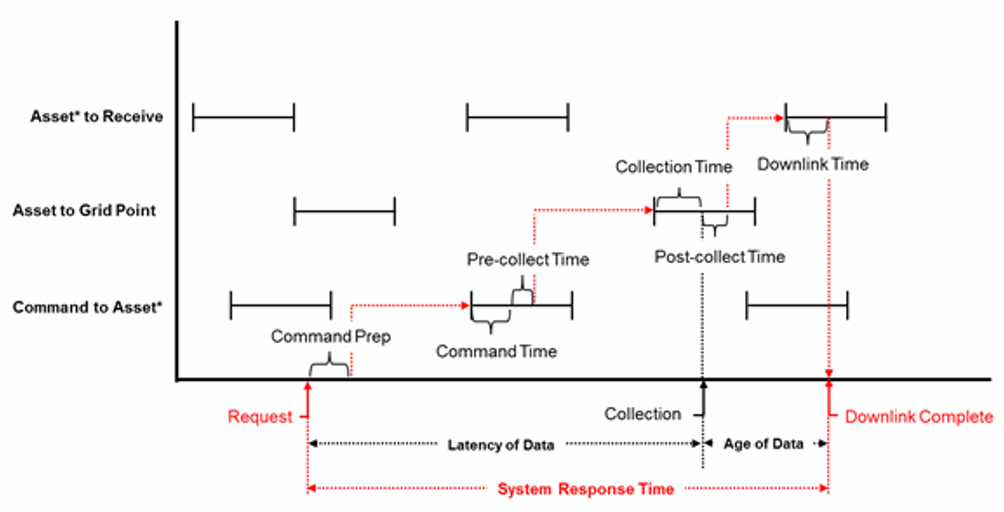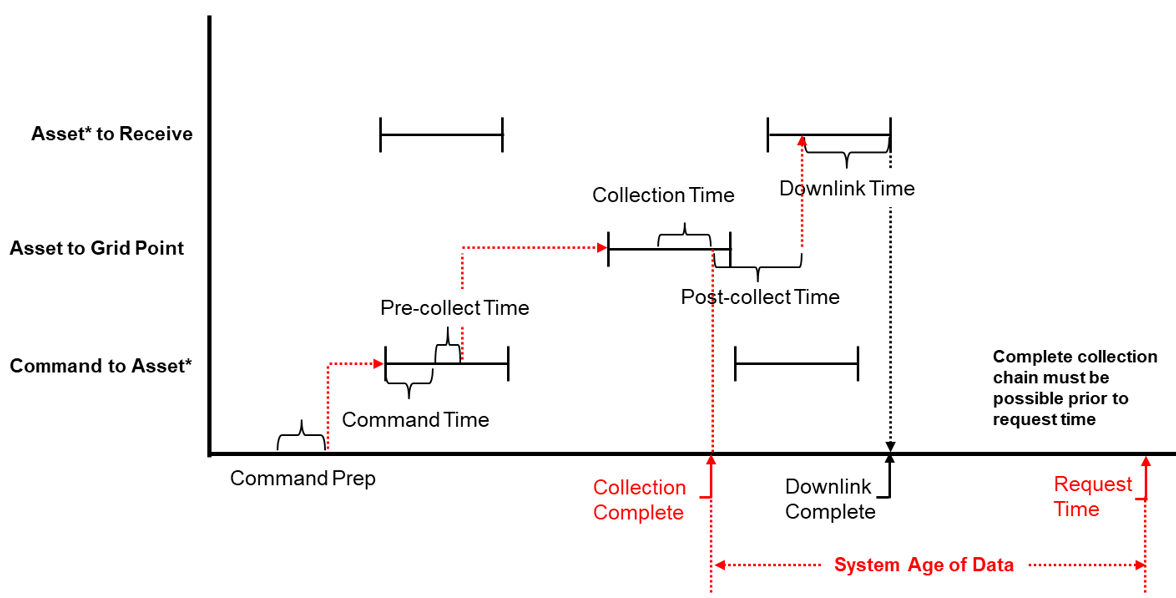Measuring System Response Time and System Age Of Data
System Age Of Data measures the time between the end of the last possible collection interval and the current time. The System Age Of Data computation requires the same event time line for identifying potential collection intervals, but only reports on the portion of the time line between the end of the collection interval until the current time of interest.
The general relationship between response time and age of data is illustrated below. Given that a request for data comes in at a specific time, the response time is a measure of how long you have to wait until you have a new version of the requested data while age of data is a measure of how long ago a prior version of the data was collected.

The overall chain of events time line is:
- A request for collection is received (during animation, the current time serves as the time of a collection request for the System Response Time computation).
- Command generation (CommandPrepTime seconds required for command gen).
- Uplink from command station – possible at end of command gen if currently in access and at least CommandTime remains in access interval. Otherwise, this has to wait until a command station access of at least CommandTime occurs.
- Asset prepares to collect (requires PreCollectDelay seconds from end of commanding).
- Asset makes collection (CollectionTime required prior to end of access period) – possible at end of PreCollectDelay if currently in access. Otherwise, this has to wait until a grid point access of at least CollectionTime occurs.
- Asset prepares to downlink data (requires PostCollectDelay seconds from end of collection).
- Downlink of data – possible at end of PostCollectDelay if currently in access and at least DownlinkTime remains in access interval. Otherwise, this has to wait until a receive station access of at least DownlinkTime occurs.
- A request for data is received and satisfied using the data from the most recent prior collection (during animation, the current time serves as the time of the data request for the System Age Of Data computation).
The computation of System Response Time is illustrated in the following figure. Note that the computation works forward in time, assuming that the earliest opportunity for each required event is utilized.

Asset* - If sub-objects (Sensors, Receivers, Transmitters, etc.) are assigned as assets, command window generation is performed based on access to the parent object.
The System Response Time is then computed as: (Time of completion of data downlink – Time of collection request). The dynamic value of System Response Time can be zero only if all delays are set to zero and if simultaneous access exists between a command station, the collection asset and a receive station.
The figure for the System Age Of Data computation is slightly different from the illustration of the System Response Time. Note that the computation works backwards in time and that events from the collection and later are assumed to occur at their latest possible times, which yields the shortest possible age of data values. Events prior to collection, such as commanding, are only required to exist to complete the chain of events, but their exact timing does not affect the value of the age of data metric. It is possible that multiple collection windows are available between the downlink window and the commanding window (when considered in backwards time). In this case, the System Age Of Data is computing using the latest viable collection window, thus yielding the shortest possible age of data value which is consistent with the use of the latest possible times within the respective windows.

The System Age Of Data is computed as: (Time of request - Time of completion of data collection). The dynamic value of System Age Of Data can be zero if all delays after the collection, PostCollectDelay and DownlinkTime, are set to zero and if simultaneous access exists between the collection asset and a receive station.
Options for the static definition of System Response Time and System Age Of Data are described in the following tables.
Compute options for System Response Time
| Option | Description |
|---|---|
| Average | The average system response time over the entire coverage interval. The average is computed by sampling the coverage analysis interval at the input step size. Samples where the system response time cannot be computed due to the coverage analysis interval ending before the downlink of data can be completed are not used in the computation of the average. |
| Maximum | The maximum system response time over the entire coverage interval. The result will be equal to the time between the last possible time when the data downlink can be completed during the coverage analysis interval and the end of the coverage analysis interval, if this span is larger than any other response time encountered. |
| Minimum | The minimum response time over the entire coverage interval. The value is 0 only if all delay times are equal to 0 and simultaneous access exists for all required communication paths. |
Compute options for System Age Of Data
| Option | Description |
|---|---|
| Average | The average system age of data over the entire coverage interval. The average is computed by sampling the coverage analysis interval at the input step size. Samples where the system age of data cannot be computed due to not having a complete collection chain prior to the request time are not used in the computation of the average. |
| Maximum | The maximum system age of data over the entire coverage interval. The result will be equal to the time between the last possible time when the data downlink can be completed during the coverage analysis interval and the end of the coverage analysis interval, if this span is larger than any other response time encountered. |
| Minimum | The minimum system age of data over the entire coverage interval. The value is 0 only if all post-collection delay times are equal to 0 and simultaneous access exists for collection and downlink. |
: End gaps are considered during the computation of Maximum values. For System Response Time, the end gap value is computed as the time between the last request time that can lead to a complete collection chain of events and the end of the analysis interval. For System Age Of Data, the end gap value is computed as the time between the start of the analysis interval and the first request time after a complete collection chain of events is possible.
Command Object
Specify the objects from which commands can be generated and uplinked to assets to schedule collections. A Constellation object can be specified if more than one command object is desired. Note that Constellation operators are not currently honored.
If sub-objects (Sensors, Receivers, Transmitters, etc.) are assigned as assets, command window generation is performed based on access to the parent object.
Receive Object
Specify the objects to which collected data can be transmitted from assets. A Constellation object can be specified if more than one receive object is desired. Note: Constellation operators are not currently honored.
If sub-objects (Sensors, Receivers, Transmitters, etc.) are assigned as assets, receive window generation is performed based on access to the parent object.
Command Prep Time
Specify the amount of time required to generate collection commands prior to uplink of the commands from the command objects to the assets.
Commanding Time
Specify the amount of time required to uplink generated collection commands from the command objects to the assets.
Pre-collection Time
Specify the amount of time required to configure an asset for collection after the collection command has been received.
Collection Time
Specify the amount of time required for an asset to perform a collection after it has been properly configured.
Post-collection Time
Specify the amount of time required to configure an asset for downlink after the collection has been completed.
Downlink Time
Specify the amount of time required to downlink generated data after the asset has been configured for downlink.
Allow Forward Crosslink
Specify if a single forward crosslink is to be allowed for commanding assets. The use of forward crosslinks allows a collection command to be passed from one asset to another which will actually do the collection. The collecting asset then downlinks the collected data. There is not currently an option for a return crosslink.
If sub-objects (Sensors, Receivers, Transmitters, etc.) are assigned as assets, crosslink window generation is performed based on access between parent objects.
Time Step
Specify the amount time to be used in computing the average value of the system response time or system age of data. Only used during the computation of satisfaction intervals for compute options other than Average.
Displaying System Response Time and System Age Of Data in a Graphics Window
Graphics are used to represent the static and dynamic value of System Response Time and System Age Of Data. Graphics representing the dynamic values are only displayed during animation. If Satisfaction is enabled, the graphics follow the general behavior for satisfaction graphics. If Satisfaction is disabled, the graphics appear as described in the following table:
| Static or Animation? | Grid points highlighted if they... |
|---|---|
| Static | Have a non-zero system response time or system age of data at some point. |
| Animation | Have a non-zero system response time or system age of data at the current time. |
The Satisfaction Threshold value is the time between a request for coverage of a point and the achievement of that request. The default behavior for this Figure Of Merit corresponds to a Satisfaction setting of Greater Than 0.